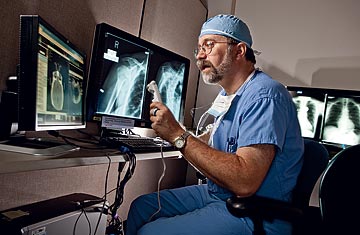
A doctor dictates notes into the digital archive.
(3 of 3)
Technology has also helped Geisinger hold down costs while making doctors' lives easier. Geisinger began installing electronic health-records systems in 1996 and since then has invested about $120 million in wiring its sites. On a recent morning, Dr. Nancy Grauso-Eby, a pediatrician working on the Danville campus, opened the record of a 4-year-old boy coming in because of an earache, and his entire history, from birth, popped up on her screen. So did a yellow alert that recommended the boy participate in a study called Garden Gang, a pilot program designed to teach kids how to eat better. When Grauso-Eby scrolled down, it was clear why the computer flagged this kid: the preschooler weighed 80 lb. (36 kg) — off the digital chart that tracks his growth curve.
While you might not need a computer to tell you that an 80-lb. 4-year-old needs to lose weight, it helps when the same system also warns about a food or drug allergy or a missed measles vaccination. When a child Grauso-Eby treats goes to see a specialist, that doctor will see the same chart, and an alert will flash if the two doctors are prescribing drugs that adversely interact. The chart will track the kid throughout life — for the orthopedist or cardiologist or obstetrician he or she sees in later years.
Running the Numbers
For doctors, lawmakers and anyone else embroiled in the health-care-reform debate, the question is, Can a system like Geisinger's go national? The short answer: in some ways it has. Pay-for-performance, episode care and global coverage have been seeping into health plans for a while.
According to a study by the AARP, 30% of primary-care physicians already have some kind of pay-for-performance incentive written into their plan contracts, and 28% of group practices include performance benchmarks. Since 2007, Massachusetts has required all its citizens to have health insurance, about 20% of which involves some kind of global coverage — handling all of a patient's health-care needs for the duration of the policy. In July, the state announced plans to go further, eliminating fee-for-service entirely within five years and mandating global care statewide. Similar plans are ramping up in Minnesota and Wisconsin. "We're going to do this incrementally," says JudyAnn Bigby, Massachusetts' secretary of health and human services. "We want to increase pay-for-performance first and episode payments next." Is five years enough to make the transition entirely? Bigby concedes she doesn't know. "No one's ever done this," she admits.
All the health-care bills making their fitful way through Congress include whacks at fee-for-service too, mostly in the form of programs that introduce episode payments or set up what are known as accountable care organizations, community-based teams of doctors who collaborate on care. The programs would be tested first among Medicare patients, but what happens in Medicare — with its 45 million recipients — ultimately drives the industry.
Still, significant unforeseens remain, as history shows. Massachusetts' highly touted experiment with universal coverage has taken hits for failing to lower health-care costs. Bigby attributes this partly to high housing and labor costs and the fact that the state is home to so many pricey academic medical centers. That may be true, but you can bet that Massachusetts' remaining one of the priciest health-care providers in the U.S. was not among the selling points when advocates of universal coverage were stumping for the plan. Similarly, global care may correct the problem — or harbor bear traps of its own.
Geisinger's financials are undeniably rock-solid: the system pulls in about $1.5 billion per year from its premiums and from other insurers, and it has a AA credit rating. But part of that is due to the similar solidity of its patient base — a homogeneous population with a predictable range of ills. The financial team prefers things this way and has resisted any calls for expansion. "We've purposely stuck to our knitting in central Pennsylvania," says Dr. Duane Davis, chief medical officer of Geisinger Health Plans. But larger plans trying to serve more-diverse communities don't have the same luxury. What's more, while Geisinger's electronic health records may be an impressive showpiece, not every provider has a loose $120 million to plow into such a system.
Finally, there's the matter of the doctors themselves. Physicians may want to get off the fee-for-service carousel, but salary-plus-incentives means that sometimes you won't meet your targets and your paycheck will dwindle. And some docs may chafe at being hitched to a team. One sweetener Dartmouth's Fisher recommends is forgiving some medical-school debts — an idea Obama endorsed at an Oct. 5 photo op with doctors, though in his plan, the break would be limited to those who agree to work in underserved or rural markets.
Overhauling fee-for-service may well make medicine less lucrative for some practitioners. But it would give others a new opportunity to practice medicine in an almost forgotten way: getting to know their patients and keeping them healthy so they can avoid a surgeon or a hospital. "It's a chance for a primary-care doctor to be a hero again," says Dr. Thomas Graf, chairman of Geisinger's community-practice team. That's not the stuff of AA bond ratings or billion-dollar revenue streams, but it just might be worth more than both.
The original version of this article misstated that neurologists can earn three times as much as family physicians. In fact neurologists on average earn $220,000 a year, compared to $179,000 that the typical family doctor earns.
